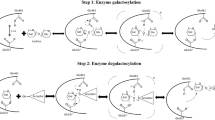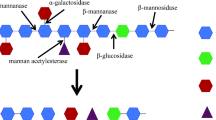Abstract
To perfect the enzymatic properties of AuMan5A, a mesophilic glycoside hydrolase (GH) family 5 β-mannanase from Aspergillus usamii, its loop-structure substitution was carried out by rational design and followed by megaprimer PCR. Based on the structural analysis and enzymatic property comparison of various β-mannanases, a piece of loop-structure with seven amino acids between two β-strands (βD and βE) in the substrate-binding groove, named “Loop DE,” was speculated to be correlative to the thermostability and catalytic efficiency of GH family 5 β-mannanases. Therefore, three AuMan5A’s mutants, AuMan5A-Af, AuMan5A-An, and AuMan5A-Th, were designed by substituting a Loop DE sequence (316KSPDGGN322) of AuMan5A with the corresponding sequences of other three family 5 β-mannanases, respectively. Then, the mutant-encoding genes, Auman5A-Af, Auman5A-An, and Auman5A-Th, were constructed as designed theoretically and then expressed in Pichia pastoris GS115. The expressed recombinant AuMan5A-Af (re-AuMan5A-Af) displayed the temperature optimum (T opt) of 75 °C, T m value of 76.6 °C and half-life (t 1/2) of 480 min at 70 °C, which were 10 and 12.1 °C higher and 48-fold longer than those of re-AuMan5A, respectively. Its catalytic efficiency (k cat/K m) was 12.7-fold that of re-AuMan5A. What is more, the site-directed mutagenesis of D320G in AuMan5A-Af was performed. The T opt and t 1/2 of expressed re-AuMan5A-AfD320G decreased to 70 °C and 40 min, respectively, while its k cat/K m was only 35 % of that of re-AuMan5A-Af. These results demonstrated that the mutation of G320 (in AuMan5A) into D320 (in AuMan5A-Af) through Loop DE substitution was mainly responsible for the thermostability and catalytic efficiency improvement of AuMan5A-Af.







Similar content being viewed by others
References
Cai H, Shi P, Huang H, Luo H, Bai Y, Yang P, Meng K, Yao B (2011a) An acidic β-mannanase from Penicillium sp. C6: gene cloning and over-expression in Pichia pastoris. World J Microbiol Biotechnol 27:2813–2819
Cai H, Shi P, Luo H, Bai Y, Huang H, Yang P, Yao B (2011b) Acidic β-mannanase from Penicillium pinophilum C1: cloning, characterization and assessment of its potential for animal feed application. J Biosci Bioeng 112:551–557
Chauhan PS, Puri N, Sharma P, Gupta N (2012) Mannanases: microbial sources, production, properties and potential biotechnological applications. Appl Microbiol Biotechnol 93:1817–1830
Chen X, Cao Y, Ding Y, Lu W, Li D (2007) Cloning, functional expression and characterization of Aspergillus sulphureus β-mannanase in Pichia pastoris. J Biotechnol 128:452–461
Cheng YS, Ko TP, Huang JW, Wu TH, Lin CY, Luo W, Li Q, Ma Y, Huang CH, Wang AHJ, Liu JR, Guo RT (2012) Enhanced activity of Thermotoga maritima cellulase 12A by mutating a unique surface loop. Appl Microbiol Biotechnol 95:661–669
Choi SH, Kim HS, Lee EY (2012) Multiple sequence alignment-inspired mutagenesis of marine epoxide hydrolase of Mugil cephalus for enhancing enantioselective hydrolytic activity. J Ind Eng Chem 18:72–76
Couturier M, Haon M, Coutinho PM, Henrissat B, Lesage-Meessen L, Berrin JG (2011) Podospora anserina hemicellulases potentiate the Trichoderma reesei secretome for saccharification of lignocellulosic biomass. Appl Environ Microbiol 77:237–246
Couturier M, Feliu J, Bozonnet S, Roussel A, Berrin JG (2013a) Molecular engineering of fungal GH5 and GH26 beta-(1,4)-mannanases toward improvement of enzyme activity. PLoS One 8:e79800
Couturier M, Roussel A, Rosengren A, Leone P, Stalbrand H, Berrin JG (2013b) Structural and biochemical analyses of glycoside hydrolase families 5 and 26 β-(1,4)-mannanases from Podospora anserina reveal differences upon manno-oligosaccharide catalysis. J Biol Chem 288:14624–14635
Dhawan S, Kaur J (2007) Microbial mannanases: an overview of production and applications. Crit Rev Biotechnol 27:197–216
Dilokpimol A, Nakai H, Gotfredsen CH, Baumann MJ, Nakai N, Abou Hachem M, Svensson B (2011) Recombinant production and characterisation of two related GH5 endo-β-1,4-mannanases from Aspergillus nidulans FGSC A4 showing distinctly different transglycosylation capacity. Biochim Biophys Acta 1814:1720–1729
Do BC, Dang TT, Berrin JG, Haltrich D, To KA, Sigoillot JC, Yamabhai M (2009) Cloning, expression in Pichia pastoris, and characterization of a thermostable GH5 mannan endo-1,4-β-mannosidase from Aspergillus niger BK01. Microb Cell Fact 8:59
Duan X, Chen J, Wu J (2013) Improving the thermostability and catalytic efficiency of Bacillus deramificans pullulanase by site-sirected mutagenesis. Appl Environ Microbiol 79:4072–4077
Ghollasi M, Ghanbari-Safari M, Khajeh K (2013) Improvement of thermal stability of a mutagenised α-amylase by manipulation of the calcium-binding site. Enzyme Microb Technol 53:406–413
Hilge M, Gloor SM, Rypniewski W, Sauer O (1998) High-resolution native and complex structures of thermostable β-mannanase from Thermomonospora fusca-substrate specificity in glycosyl hydrolase family 5. Structure 6:1433–1444
Huang JW, Chen CC, Huang CH, Huang TY, Wu TH, Cheng YS, Ko TP, Lin CY, Liu JR, Guo RT (2014) Improving the specific activity of β-mannanase from Aspergillus niger BK01 by structure-based rational design. Biochim Biophys Acta 1844:663–669
Jang MK, Lee SW, Lee DG, Kim NY, Yu KH, Jang HJ, Kim S, Kim A, Lee SH (2010) Enhancement of the thermostability of a recombinant β-agarase, AgaB, from Zobellia galactanivorans by random mutagenesis. Biotechnol Lett 32:943–949
Jaouadi B, Aghajari N, Haser R, Bejar S (2010) Enhancement of the thermostability and the catalytic efficiency of Bacillus pumilus CBS protease by site-directed mutagenesis. Biochimie 92:360–369
Laemmli UK (1970) Cleavage of structural proteins during the assembly of the head of Bacteriophage T4. Nature 227:680–685
Li JF, Zhao SG, Tang CD, Wang JQ, Wu MC (2012) Cloning and functional expression of an acidophilic β-mannanase gene (Anman5A) from Aspergillus niger LW-1 in Pichia pastoris. J Agric Food Chem 60:765–773
Li J, Wei X, Tang C, Wang J, Zhao M, Pang Q, Wu M (2014) Directed modification of the Aspergillus usamii β-mannanase to improve its substrate affinity by in silico design and site-directed mutagenesis. J Ind Microbiol Biotechnol 41:693–700
Lu H, Zhang H, Shi P, Luo H, Wang Y, Yang P, Yao B (2013) A family 5 β-mannanase from the thermophilic fungus Thielavia arenaria XZ7 with typical thermophilic enzyme features. Appl Microbiol Biotechnol 97:8121–8128
Lu H, Luo H, Shi P, Huang H, Meng K, Yang P, Yao B (2014) A novel thermophilic endo-β-1,4-mannanase from Aspergillus nidulans XZ3: functional roles of carbohydrate-binding module and Thr/Ser-rich linker region. Appl Microbiol Biotechnol 98:2155–2163
Moreira LRS, Filho EXF (2008) An overview of mannan structure and mannan-degrading enzyme systems. Appl Microbiol Biotechnol 79:165–178
Niesen FH, Berglund H, Vedadi M (2007) The use of differential scanning fluorimetry to detect ligand interactions that promote protein stability. Nat Protoc 2:2212–2221
Pham TA, Berrin JG, Record E, To KA, Sigoillot JC (2010) Hydrolysis of softwood by Aspergillus mannanase: role of a carbohydrate-binding module. J Biotechnol 148:163–170
Puchart V, Vrsanska M, Svoboda P, Pohl J, Ogel ZB, Biely P (2004) Purification and characterization of two forms of endo-β-1,4-mannanase from a thermotolerant fungus, Aspergillus fumigatus IMI 385708 (formerly Thermomyces lanuginosus IMI 158749). Biochim Biophys Acta 1674:239–250
Sabini E, Schubert H, Murshudov G, Wilson KS, Siika-Aho M, Penttila M (2000) The three-dimensional structure of a Trichoderma reesei β-mannanase from glycoside hydrolase family 5. Acta Cryst D56:3–13
Stålbrand H, Siika-aho M, Tenkanen M, Viikari L (1993) Purification and characterization of two β-mannanases from Trichoderma reesei. J Biotechnol 29:229–242
Tang C, Guo J, Wu M, Zhao S, Shi H, Li J, Zhang H, Wang J (2011) Cloning and bioinformatics analysis of a novel acidophilic β-mannanase gene, Auman5A, from Aspergillus usamii YL-01-78. World J Microbiol Biotechnol 27:2921–2929
Tang CD, Li JF, Wei XH, Min R, Gao SJ, Wang JQ, Yin X, Wu MC (2013) Fusing a carbohydrate-binding module into the Aspergillus usamii β-mannanase to improve its thermostability and cellulose-binding capacity by in silico design. PLoS One 8:e64766
Tang CD, Guo J, Li JF, Wei XH, Hu D, Gao SJ, Yin X, Wu MC (2014) Enhancing expression level of an acidophilic β-mannanase in Pichia pastoris by double vector system. Ann Microbiol 64:561–569
van Zyl WH, Rose SH, Trollope K, Görgens JF (2010) Fungal β-mannanases: mannan hydrolysis, heterologous production and biotechnological applications. Process Biochem 45:1203–1213
Voutilainen SP, Murray PG, Tuohy MG, Koivula A (2010) Expression of Talaromyces emersonii cellobiohydrolase Cel7A in Saccharomyces cerevisiae and rational mutagenesis to improve its thermostability and activity. Protein Eng Des Sel 23:69–79
Wang J, Zeng D, Liu G, Wang S, Yu S (2014) Truncation of a mannanase from Trichoderma harzianum improves its enzymatic properties and expression efficiency in Trichoderma reesei. J Ind Microbiol Biotechnol 41:125–133
Xie ZH, Shi XJ (2009) Fast and almost 100% efficiency site-directed mutagenesis by the megaprimer PCR method. Prog Biochem Biophys 36:1490–1494
Xie J, Song L, Li X, Yi X, Xu H, Li J, Qiao D, Cao Y (2011) Site-directed mutagenesis and thermostability of xylanase XYNB from Aspergillus niger 400264. Curr Microbiol 62:242–248
Xu M, Zhang R, Liu X, Shi J, Xu Z, Rao Z (2013) Improving the acidic stability of a β-mannanase from Bacillus subtilis by site-directed mutagenesis. Process Biochem 48:1166–1173
Zhang Y, Ju J, Peng H, Gao F, Zhou C, Zeng Y, Xue Y, Li Y, Henrissat B, Gao GF, Ma Y (2008) Biochemical and structural characterization of the intracellular mannanase AaManA of Alicyclobacillus acidocaldarius reveals a novel glycoside hydrolase family belonging to clan GH-A. J Biol Chem 283:31551–31558
Acknowledgments
The authors are grateful to Prof. Xianzhang Wu (School of Biotechnology, Jiangnan University, Jiangsu, China) for providing technical assistance.
Author information
Authors and Affiliations
Corresponding author
Ethics declarations
Conflict of interest
All the authors declare that they have no competing interests.
Funding
This work was financially supported by the National Nature Science Foundation of China (No. 31271811), the Fundamental Research Funds for the Central Universities of China (JUSRP51412B) and the Postgraduate Innovation Training Project of Jiangsu, China (KYLX_1170).
Ethical Statement
This article does not contain any studies with human participants or animals performed by any of the authors.
Additional information
Yun Hai Dong and Jian Fang Li contributed equally to this work.
Electronic supplementary material
Below is the link to the electronic supplementary material.
ESM 1
(PDF 516 kb)
Rights and permissions
About this article
Cite this article
Dong, Y.H., Li, J.F., Hu, D. et al. Replacing a piece of loop-structure in the substrate-binding groove of Aspergillus usamii β-mannanase, AuMan5A, to improve its enzymatic properties by rational design. Appl Microbiol Biotechnol 100, 3989–3998 (2016). https://doi.org/10.1007/s00253-015-7224-7
Received:
Revised:
Accepted:
Published:
Issue Date:
DOI: https://doi.org/10.1007/s00253-015-7224-7




